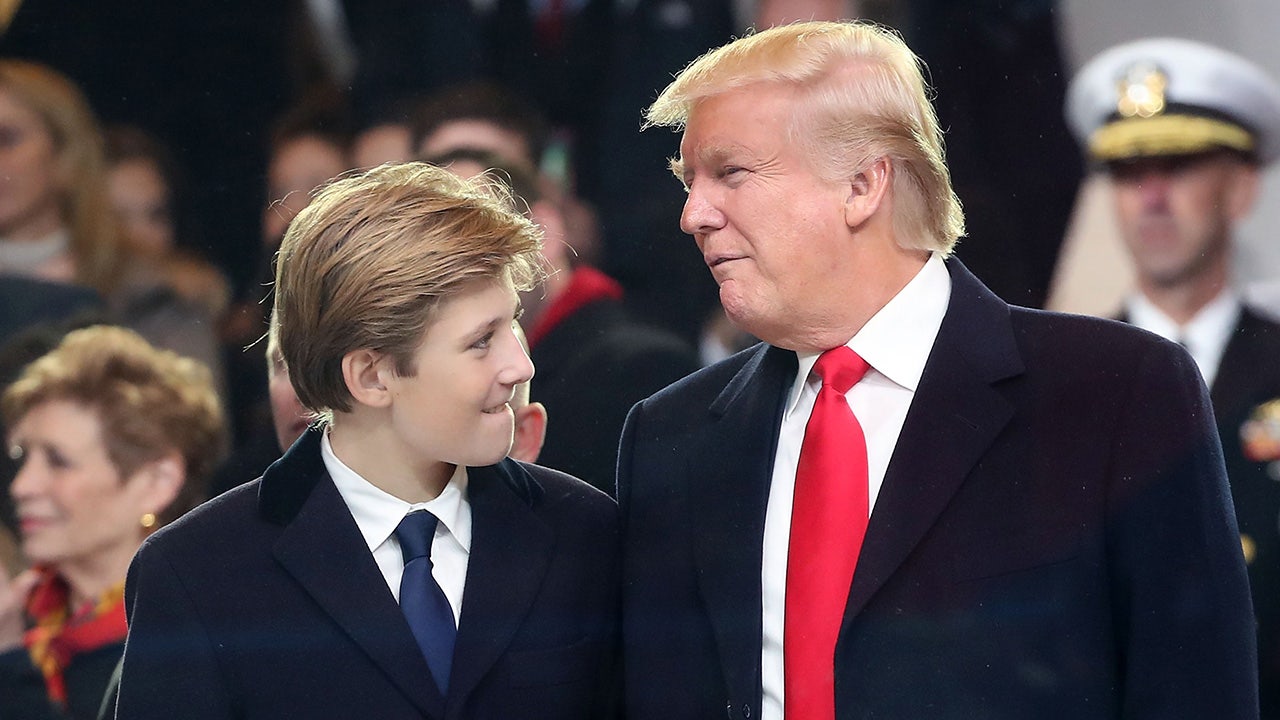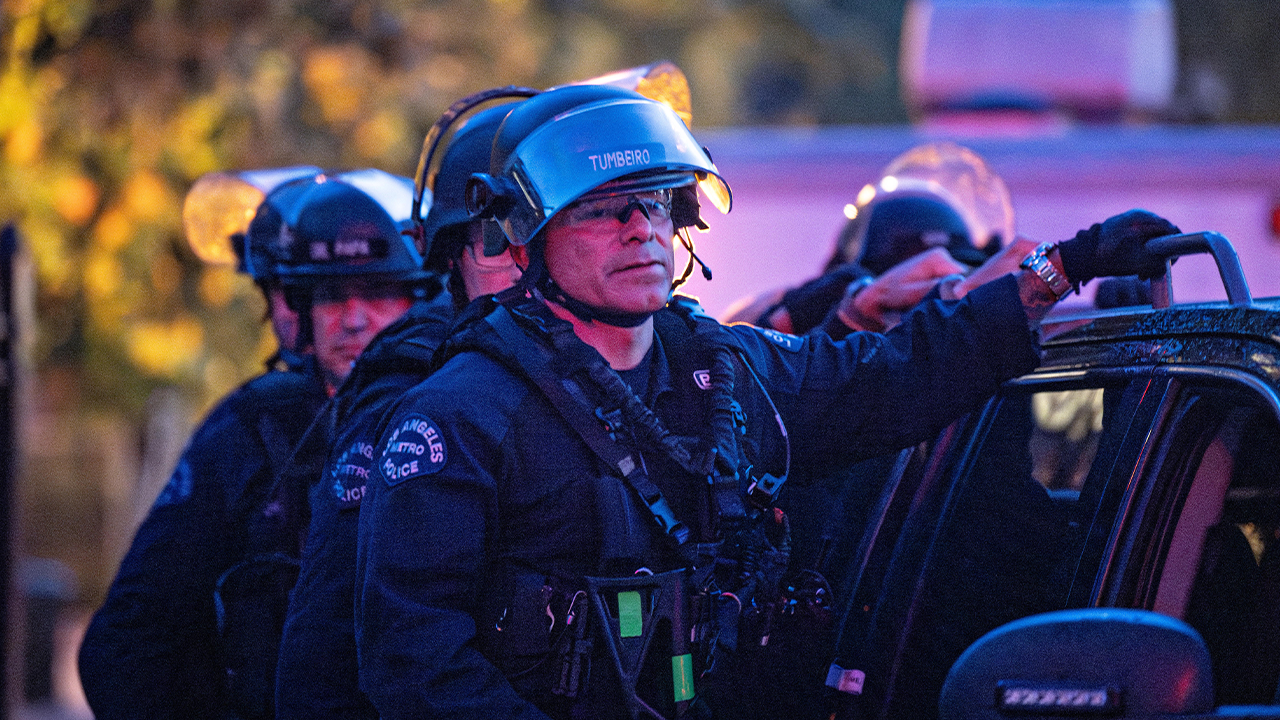Education
America’s Semiconductor Boom Faces a Challenge: Not Enough Workers

Maxon Wille, an 18-year-old in Surprise, Ariz., was driving toward Interstate 17 last year when he noticed a massive construction site: Taiwan Semiconductor Manufacturing Company at work on its new factory in Phoenix.
A few weeks later, as he was watching YouTube, an advertisement popped up for a local community college’s 10-day program that trains people to become semiconductor technicians. He graduated from the course this month and now hopes to work at the plant once it opens.
“I can see this being the next big thing,” Mr. Wille said.
Semiconductor manufacturers say they will need to attract more workers like Mr. Wille to staff the plants that are being built across the United States. America is on the cusp of a semiconductor manufacturing boom, strengthened by billions of dollars that the federal government is funneling into the sector. President Biden had said the funding will create thousands of well-paying jobs, but one question looms large: Will there be enough workers to fill them?
“My biggest fear is investing in all this infrastructure and not having the people to work there,” said Shari Liss, the executive director of the SEMI Foundation, a nonprofit arm of SEMI, an association that represents electronics manufacturing companies. “The impact could be really substantial if we don’t figure out how to create excitement and interest in this industry.”
Lawmakers passed the 2022 CHIPS Act with lofty ambitions to remake the United States into a semiconductor powerhouse, in part to reduce America’s reliance on foreign nations for the tiny chips that power everything from dishwashers to computers to cars. The law included $39 billion to fund the construction of new and expanded semiconductor facilities, and manufacturers that want a slice of the subsidies have already announced expansions across the country.
More than 50 new facility projects have been announced since the CHIPS Act was introduced, and private companies have pledged more than $210 billion in investments, according to the Semiconductor Industry Association.
But that investment has run headfirst into the tightest labor market in years, with employers across the country struggling to find workers. Semiconductor manufacturers have long found it difficult to hire workers because of a lack of awareness of the industry and too few students entering relevant academic fields. Company officials say they expect it to become even more difficult to hire for a range of critical positions, including the construction workers building the plants, the technicians operating equipment and engineers designing chips.
The U.S. semiconductor industry could face a shortage of about 70,000 to 90,000 workers over the next few years, according to a Deloitte report. McKinsey has also projected a shortfall of about 300,000 engineers and 90,000 skilled technicians in the United States by 2030.
Semiconductor manufacturers have struggled to hire more employees, in part because, officials say, there are not enough skilled workers and they have to compete with big technology firms for engineers. Many students who graduate with advanced engineering degrees in the United States were born abroad, and immigration rules make it challenging to obtain visas to work in the country.
Ronnie Chatterji, the White House’s CHIPS implementation coordinator, said that filling the new jobs would be a big challenge, but that he felt confident Americans would want them as they became more aware of the industry’s domestic expansion.
“While it hasn’t been the sexiest job opportunity for folks compared to some of the other things that they’re graduating with, it also hasn’t been on the radar,” Mr. Chatterji said. He added that America would be less “prosperous” if companies could increase output but lacked the employees to do so.
In an effort to meet the labor demand, the Biden administration said this month that it would create five initial “work force hubs” in cities like Phoenix and Columbus, Ohio, to help train more women, people of color and other underrepresented workers in industries like semiconductor manufacturing.
Administration and company officials have also pushed for changes to better retain foreign-born STEM graduates, but immigration remains a controversial topic in Washington, and few are optimistic about reforms.
Some industry leaders are looking to technology as an antidote, since automation and artificial intelligence can amplify the output of a single engineer, but companies are mostly putting their faith into training programs. Federal officials have backed that effort and pointed out that funding in the CHIPS Act could be used for work force development.
Intel, which announced plans to spend $20 billion on two new chip factories in Arizona and more than $20 billion on a new chip manufacturing complex in Ohio, has invested millions in partnerships with community colleges and universities to train technicians and expand relevant curriculum.
Gabriela Cruz Thompson, the director of university research collaboration at Intel Labs, said the company anticipated creating 6,700 jobs over the next five to 10 years. About 70 percent would be for technicians who typically have a two-year degree or certificate.
She said that the industry had faced staffing challenges for years, and that she was concerned about the number of “available and talented skilled workers” who could fill all of the new Intel positions.
“I am confident,” she said. “But am I fully certain, 100 percent? No.”
Micron, which pledged as much as $100 billion over the next two decades or more to build a huge chip factory complex in New York, has also deployed new work force programs, including ones that train veterans and teach middle and high school students about STEM careers through “chip camps.”
Bo Machayo, the director of U.S. federal affairs at Micron, said the company anticipated needing roughly 9,000 employees after its full build-out in the region.
“We understand that it’s a challenge, but we also look at it as an opportunity,” he said.
To be considered for the federal subsidies, manufacturers must submit applications to the Commerce Department that include detailed plans about how they will recruit and retain workers. Firms requesting more than $150 million are expected to provide affordable, high-quality child care.
“We don’t think that a company can just post a bunch of jobs online and hope that the right work force shows up,” said Kevin Gallagher, a senior adviser to the commerce secretary.
The lack of interest in the industry has been evident at academic institutions. Karl Hirschman, the director of microelectronic engineering at the Rochester Institute of Technology, said the university was “nowhere close” to the maximum enrollment for its microelectronic engineering degree program, which sets up students for semiconductor-related careers. Enrollment averages about 20 new undergraduates each year, compared with more than 200 for the university’s mechanical engineering program.
Although students graduating with more popular engineering degrees could work in the semiconductor industry, Mr. Hirschman said, many of them are more aware of and attracted to tech firms like Google and Facebook.
“We do not have enough students to fill the need,” he said. “It’s only going to get more challenging.”
Community colleges, universities and school districts are creating or expanding programs to attract more students to the industry.
In Maricopa County, Ariz., three community colleges have teamed up with Intel to offer a “quick start” program to prepare students to become entry-level technicians in just 10 days. During the four-hour classes, students learn the basics of how chips are made, practice using hand tools and try on the head-to-toe gowns that technicians wear.
More than 680 students have enrolled in the program since it began in July, said Leah Palmer, the executive director of the Arizona Advanced Manufacturing Institute at Mesa Community College. The program is free for in-state students who complete it and pass a certification test.
In Oregon last year, the Hillsboro School District started a two-year advanced manufacturing apprenticeship program that allows 16- to 18-year-old students to earn high school credit and be paid to work on the manufacturing floors of companies in the semiconductor industry. Five students are participating, and officials hope to add at least three more to the next cohort, said Claudia Rizo, the district’s youth apprenticeship project manager.
“Our hope is that students would have a job offer with the companies if they decide to stay full time, but also be open to the possibility of pursuing postsecondary education through college or university,” Ms. Rizo said.
Universities are also expanding undergraduate and graduate engineering programs. Purdue started a semiconductor degree program last year, and Syracuse, which has worked with Micron and 20 other institutions to enhance related curriculum, plans to increase its engineering enrollment 50 percent over the next three to five years.
At Onondaga Community College, near Micron’s build-out in New York, officials will offer a new two-year degree and one-year certificate in electromechanical technology starting this fall. The programs were already underway before Micron’s announcement to build the chip factory complex but would help students gain the qualifications needed to work there, said Timothy Stedman, the college’s dean of natural and applied sciences.
Although he felt optimistic, he said interest could be lower than officials hoped. Enrollment in the college’s electrical and mechanical technology programs has noticeably declined from two decades ago because more students have started to view four-year college degrees as the default path.
“We’re starting to see the pendulum swing a little bit as people have realized that these are well-paying jobs,” Mr. Stedman said. “But I think there still needs to be a fair amount of work done.”
Ana Swanson contributed reporting.

Education
Video: Police Use Pepper Spray on Protesters on G.W.U.’s Campus

new video loaded: Police Use Pepper Spray on Protesters on G.W.U.’s Campus
transcript
transcript
Police Use Pepper Spray on Protesters on G.W.U.’s Campus
Police officers arrested 33 pro-Palestinian protesters and cleared a tent encampment on the campus of George Washingon University.
-
“The Metropolitan Police Department. If you are currently on George Washington University property, you are in violation of D.C. Code 22-3302, unlawful entry on property.” “Back up, dude, back up. You’re going to get locked up tonight — back up.” “Free, free Palestine.” “What the [expletive] are you doing?” [expletives] “I can’t stop — [expletives].”
Recent episodes in Israel-Hamas War
Education
How Counterprotesters at U.C.L.A. Provoked Violence, Unchecked for Hours

A satellite image of the UCLA campus.
On Tuesday night, violence erupted at an encampment that pro-Palestinian protesters had set up on April 25.
The image is annotated to show the extent of the pro-Palestinian encampment, which takes up the width of the plaza between Powell Library and Royce Hall.
The clashes began after counterprotesters tried to dismantle the encampment’s barricade. Pro-Palestinian protesters rushed to rebuild it, and violence ensued.
Arrows denote pro-Israeli counterprotesters moving towards the barricade at the edge of the encampment. Arrows show pro-Palestinian counterprotesters moving up against the same barricade.
Police arrived hours later, but they did not intervene immediately.
An arrow denotes police arriving from the same direction as the counterprotesters and moving towards the barricade.
A New York Times examination of more than 100 videos from clashes at the University of California, Los Angeles, found that violence ebbed and flowed for nearly five hours, mostly with little or no police intervention. The violence had been instigated by dozens of people who are seen in videos counterprotesting the encampment.
The videos showed counterprotesters attacking students in the pro-Palestinian encampment for several hours, including beating them with sticks, using chemical sprays and launching fireworks as weapons. As of Friday, no arrests had been made in connection with the attack.
To build a timeline of the events that night, The Times analyzed two livestreams, along with social media videos captured by journalists and witnesses.
The melee began when a group of counterprotesters started tearing away metal barriers that had been in place to cordon off pro-Palestinian protesters. Hours earlier, U.C.L.A. officials had declared the encampment illegal.
Security personnel hired by the university are seen in yellow vests standing to the side throughout the incident. A university spokesperson declined to comment on the security staff’s response.
Mel Buer/The Real News Network
It is not clear how the counterprotest was organized or what allegiances people committing the violence had. The videos show many of the counterprotesters were wearing pro-Israel slogans on their clothing. Some counterprotesters blared music, including Israel’s national anthem, a Hebrew children’s song and “Harbu Darbu,” an Israeli song about the Israel Defense Forces’ campaign in Gaza.
As counterprotesters tossed away metal barricades, one of them was seen trying to strike a person near the encampment, and another threw a piece of wood into it — some of the first signs of violence.
Attacks on the encampment continued for nearly three hours before police arrived.
Counterprotesters shot fireworks toward the encampment at least six times, according to videos analyzed by The Times. One of them went off inside, causing protesters to scream. Another exploded at the edge of the encampment. One was thrown in the direction of a group of protesters who were carrying an injured person out of the encampment.
Mel Buer/The Real News Network
Some counterprotesters sprayed chemicals both into the encampment and directly at people’s faces.
Sean Beckner-Carmitchel via Reuters
At times, counterprotesters swarmed individuals — sometimes a group descended on a single person. They could be seen punching, kicking and attacking people with makeshift weapons, including sticks, traffic cones and wooden boards.
StringersHub via Associated Press, Sergio Olmos/Calmatters
In one video, protesters sheltering inside the encampment can be heard yelling, “Do not engage! Hold the line!”
In some instances, protesters in the encampment are seen fighting back, using chemical spray on counterprotesters trying to tear down barricades or swiping at them with sticks.
Except for a brief attempt to capture a loudspeaker used by counterprotesters, and water bottles being tossed out of the encampment, none of the videos analyzed by The Times show any clear instance of encampment protesters initiating confrontations with counterprotesters beyond defending the barricades.
Shortly before 1 a.m. — more than two hours after the violence erupted — a spokesperson with the mayor’s office posted a statement that said U.C.L.A officials had called the Los Angeles Police Department for help and they were responding “immediately.”
Officers from a separate law enforcement agency — the California Highway Patrol — began assembling nearby, at about 1:45 a.m. Riot police with the L.A.P.D. joined them a few minutes later. Counterprotesters applauded their arrival, chanting “U.S.A., U.S.A., U.S.A.!”
Just four minutes after the officers arrived, counterprotesters attacked a man standing dozens of feet from the officers.
Twenty minutes after police arrive, a video shows a counterprotester spraying a chemical toward the encampment during a scuffle over a metal barricade. Another counterprotester can be seen punching someone in the head near the encampment after swinging a plank at barricades.
Fifteen minutes later, while those in the encampment chanted “Free, free Palestine,” counterprotesters organized a rush toward the barricades. During the rush, a counterprotester pulls away a metal barricade from a woman, yelling “You stand no chance, old lady.”
Throughout the intermittent violence, officers were captured on video standing about 300 feet away from the area for roughly an hour, without stepping in.
It was not until 2:42 a.m. that officers began to move toward the encampment, after which counterprotesters dispersed and the night’s violence between the two camps mostly subsided.
The L.A.P.D. and the California Highway Patrol did not answer questions from The Times about their responses on Tuesday night, deferring to U.C.L.A.
While declining to answer specific questions, a university spokesperson provided a statement to The Times from Mary Osako, U.C.L.A.’s vice chancellor of strategic communications: “We are carefully examining our security processes from that night and are grateful to U.C. President Michael Drake for also calling for an investigation. We are grateful that the fire department and medical personnel were on the scene that night.”
L.A.P.D. officers were seen putting on protective gear and walking toward the barricade around 2:50 a.m. They stood in between the encampment and the counterprotest group, and the counterprotesters began dispersing.
While police continued to stand outside the encampment, a video filmed at 3:32 a.m. shows a man who was walking away from the scene being attacked by a counterprotester, then dragged and pummeled by others. An editor at the U.C.L.A. student newspaper, the Daily Bruin, told The Times the man was a journalist at the paper, and that they were walking with other student journalists who had been covering the violence. The editor said she had also been punched and sprayed in the eyes with a chemical.
On Wednesday, U.C.L.A.’s chancellor, Gene Block, issued a statement calling the actions by “instigators” who attacked the encampment unacceptable. A spokesperson for California Gov. Gavin Newsom criticized campus law enforcement’s delayed response and said it demands answers.
Los Angeles Jewish and Muslim organizations also condemned the attacks. Hussam Ayloush, the director of the Greater Los Angeles Area office of the Council on American-Islamic Relations, called on the California attorney general to investigate the lack of police response. The Jewish Federation Los Angeles blamed U.C.L.A. officials for creating an unsafe environment over months and said the officials had “been systemically slow to respond when law enforcement is desperately needed.”
Fifteen people were reportedly injured in the attack, according to a letter sent by the president of the University of California system to the board of regents.
The night after the attack began, law enforcement warned pro-Palestinian demonstrators to leave the encampment or be arrested. By early Thursday morning, police had dismantled the encampment and arrested more than 200 people from the encampment.
Education
Video: President Biden Addresses Campus Protests

new video loaded: President Biden Addresses Campus Protests
transcript
transcript
President Biden Addresses Campus Protests
President Biden defended the right of demonstrators to protest peacefully, but condemned the “chaos” that has prevailed at many colleges nationwide.
-
Violent protest is not protected. Peaceful protest is. It’s against the law when violence occurs. Destroying property is not a peaceful protest. It’s against the law. Vandalism, trespassing, breaking windows, shutting down campuses, forcing the cancellation of classes and graduations — none of this is a peaceful protest. Threatening people, intimidating people, instilling fear in people is not peaceful protest. It’s against the law. Dissent is essential to democracy, but dissent must never lead to disorder or to denying the rights of others, so students can finish the semester and their college education. There’s the right to protest, but not the right to cause chaos. People have the right to get an education, the right to get a degree, the right to walk across the campus safely without fear of being attacked. But let’s be clear about this as well. There should be no place on any campus — no place in America — for antisemitism or threats of violence against Jewish students. There is no place for hate speech or violence of any kind, whether it’s antisemitism, Islamophobia or discrimination against Arab Americans or Palestinian Americans. It’s simply wrong. There’s no place for racism in America.
Recent episodes in Politics
-

 News1 week ago
News1 week agoPolice enter UCLA anti-war encampment; Arizona repeals Civil War-era abortion ban
-

 News1 week ago
News1 week agoSome Florida boaters seen on video dumping trash into ocean have been identified, officials say
-

 Politics1 week ago
Politics1 week agoThe White House has a new curator. Donna Hayashi Smith is the first Asian American to hold the post
-

 Education1 week ago
Education1 week agoVideo: President Biden Addresses Campus Protests
-
)
) Movie Reviews1 week ago
Movie Reviews1 week agoThe Idea of You Movie Review: Anne Hathaway’s honest performance makes the film stand out in a not so formulaic rom-com
-

 World1 week ago
World1 week agoUN, EU, US urge Georgia to halt ‘foreign agents’ bill as protests grow
-

 World1 week ago
World1 week agoIn the upcoming European elections, peace and security matter the most
-

 World1 week ago
World1 week agoArizona Senate repeals near-total 1864 abortion ban in divisive vote














